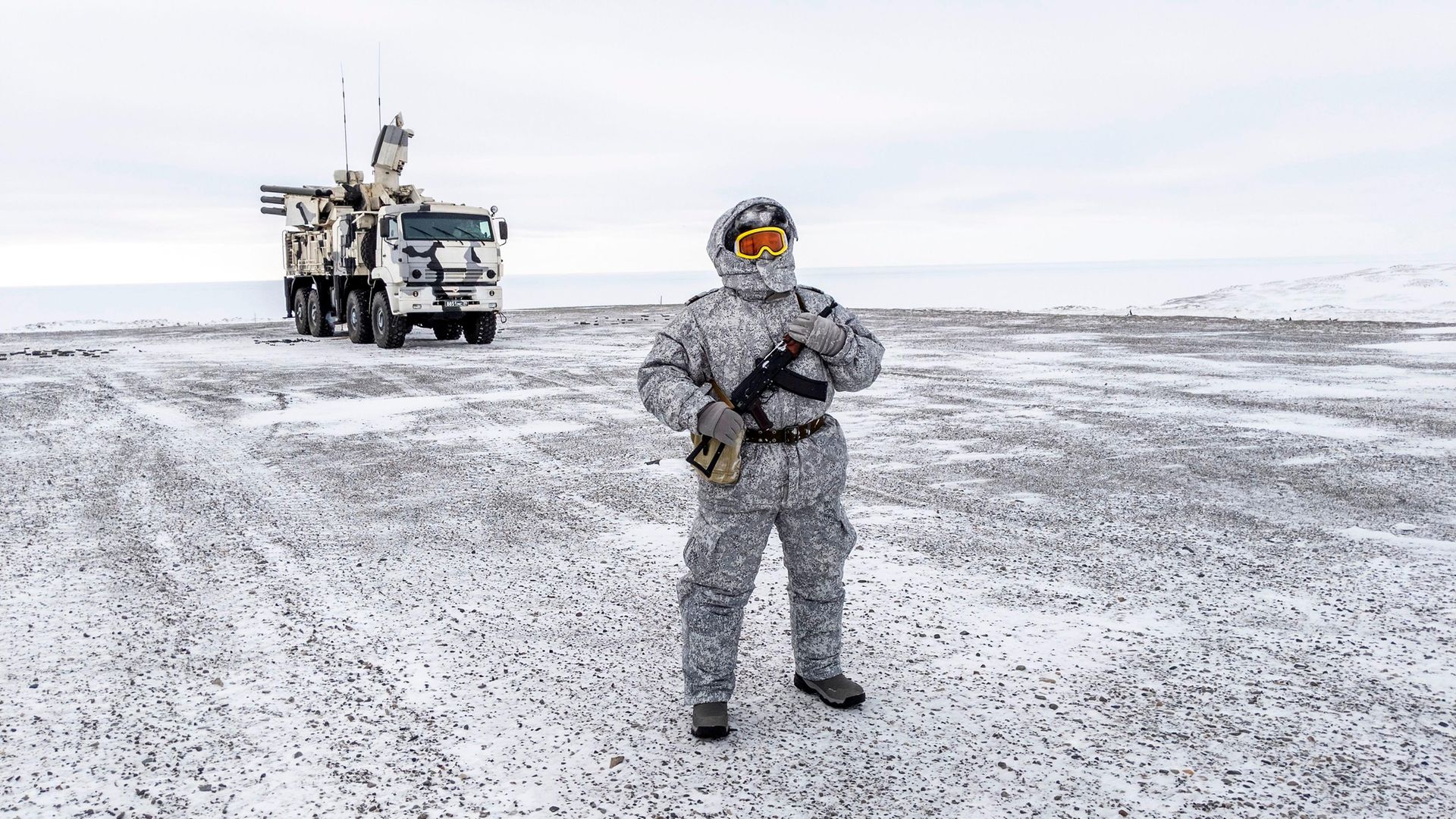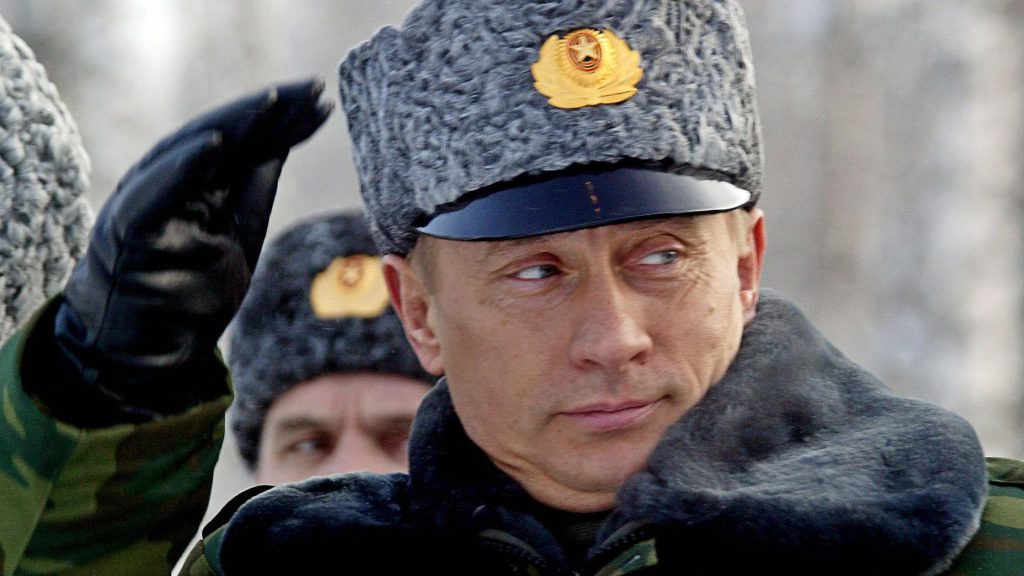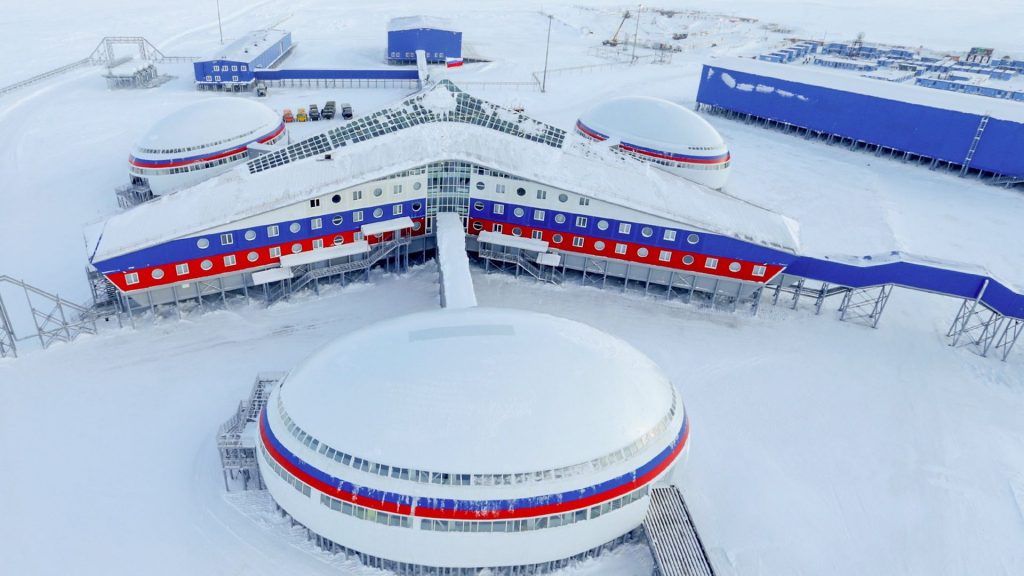
Climate change has transformed the Arctic into one of the most politically dangerous regions on the planet. Now, Vladimir Putin is ramping up the rhetoric.
If the James Bond franchise is looking for a baddy for its next film, it wouldn’t need to bother auditioning Vladimir Putin. He relishes the part; he plays to the gallery.
On the eve of crucial talks on the growing tension in one of the most hidden and dangerous places on earth, the Arctic, the Russian president said this before the TV cameras: “Everyone wants to bite off somewhere or to bite off something from us. But they should know, those who are going to do this, that we will knock out their teeth so that they can’t bite.” He punctuated his remarks with a line attributed to Tsar Alexander III: “Everyone is afraid of our vastness.”
Meanwhile, the Kremlin’s sophisticated media operation took a phalanx of the world’s media, among them CNN and the BBC to its forward polar station called Trefoil on Franz Josef Land, a collection of glacier-covered islands which until a few years ago was home to polar bears, walruses and rare bird species.
The warming climate has changed everything, militarily and economically, in the northernmost reaches of the world.
The Russians did everything they could to play up the drama, showing the reporters bomber aircraft, radar and missile batteries, outside a high-tech station that houses 150 service personnel. The commander of the base described it as “like a space station, just in the Arctic emptiness instead of in orbit”.
They would not have been displeased when the New York Times described it as the start of a “Very Cold War”.
Although temperatures can plunge to minus 50 degrees Celsius, it is not as cold as it was. The Arctic region is warming at three times faster the rate than the global average, melting permafrost and damaging the livelihoods of indigenous groups. Almost one million square miles of ice has already been lost; within a couple of decades a vast area reaching all the way to the North Pole could be ice free during summer months.

For Russia it is a moment of great opportunity, but also of potential threat. Throughout its history, Russia saw the frozen wastes as its defence shield. It also has by far the longest and most exposed northern border.
The country already has the most significant military presence above the Arctic circle. Tensions with Nato are rising, with each side shadowing each other’s ships during exercises and carrying out long-range bomber overflights and trying to jam navigation communications.
In March, three nuclear-powered submarines simultaneously smashed through the ice during a military exercise, a manoeuvre not seen before. The Russian navy filmed the moment with a drone and posted the footage online for the world to take notice. Putin described the feat as having “no analogues in Soviet history and in the history of modern Russia”.
Last month, Russia announced plans to test a “super-weapon”, the Poseidon 2M39 torpedo, in the Arctic. The unmanned missile, whose existence was apparently purposefully ‘leaked’ by the Russian military in 2015, is powered by a nuclear reactor and intended to sneak past coastal defences on the sea floor. Western military experts say the missile could trigger radioactive tsunamis off America’s eastern coast. Putin has asked his defence minister, Sergei Shoigu, for regular updates.
Some of the apparent military planning could well be borrowed from 007 and his foes. Various reports have claimed that Russia is undertaking a secret programme to train seals and beluga whales wearing mysterious harnesses for as-yet unknown missions. Two years ago, it is said that one whale turned up in Norway, presumably having lost its bearings.
Nato is stepping up activity in the region. In 2018, the US navy deployed an aircraft carrier in the Norwegian Sea for the first time since the 1980s, while in February, Washington sent strategic bombers to train. US officials confirmed last August that they had sent their stealth Seawolf submarine into the region.
All this formed the backdrop for a summit last week in Iceland of the Arctic Council. The group, which was formed during a time of greater harmony 25 years ago, comprises Canada, Denmark, Finland, Iceland, Norway, Russia, Sweden and the US. It also includes six groups representing indigenous peoples. Tellingly, Russia has taken over the rotating presidency, for the next two years.
The Council concluded its meeting by agreeing a 10-year strategic plan that focused on climate and the future of local populations. Important though that was, it avoided the big issue. Officially, military and security are not the preserve of the gathering. The real talking in the margins of the council, with US secretary of state, Antony Blinken meeting his Russian counterpart, Sergei Lavrov. It was the first face-to-face high-level encounter between the US and the Kremlin since president Joe Biden took office in January.
Prior to the talks, both sides put down their markers. “This is our land; and these are our waters,” Lavrov declared before setting off from Moscow. “Everything that our country is doing there is absolutely legal and legitimate.”

Blinken accused Russia of violating international maritime law and increasing military tension. “It is our hope that the Arctic remains an area of peaceful cooperation and peaceful collaboration,” he said, adding that Russian activity risks “accidents [and] miscalculations”.
Putin is determined to do whatever it takes to ensure that Russia is restored to its rightful position as a serious global power. The Arctic is a strategic, but also symbolic, theatre. The area was largely abandoned in the post-communist years of the 1990s.
During that period, as a Moscow-based journalist, I made several visits to a region that was being opened up to the world for the first time. One trip was to the once top-secret nuclear testing installation of Novaya Zemlya in the high Arctic; I also travelled to the bases of Murmansk and to the military port of Vladivostok. They gave the impression of starting to fall into decay. All that was turned around in the early Putin years.
Nato strategists are worried, but they are also wary of being seen to respond excitedly to what they see as partly posturing. The Kremlin’s focus on the Arctic is based as much in economics as in military thinking.
Russia is hoping to make use of the Northern Sea Route as a way of shipping oil and gas to overseas markets far more quickly than before. In 2017, in an alarming ecological development, but one that could also transform global trade, the first Russian vessel travelled along it without the use of icebreakers.
China is also trying to get in on the act, announcing plans for a ‘Polar Silk Road’ and declaring itself to be a “near-Arctic state”. It was allowed into the Arctic Council as an observer in 2013. China has made no secret of its interest in the natural resources contained in the vast territory, and the opening up of new maritime routes. Chinese investors have tried, so far unsuccessfully, to secure mining deals in Canada and Greenland to excavate rare earth minerals.
Although America regards China as by far the greater strategic threat, in the Arctic the action is with Russia. The White House calls the relationships with both countries “naturally competitive, sometimes adversarial and, on key issues, necessarily collaborative”. Can this balance be struck? A first meeting between Putin and Biden is expected to be held in the coming months.
Relations have not been so low for decades, dominated by cyber-attacks, election interference, the attempted assassination and incarceration of opposition leader Alexei Navalny, and resulting Western sanctions. And that is before mentioning the proxy war in Ukraine and annexation of Crimea.
For Blinken, this four-day tour to the far north may end up being one of his most exotic. He ended it by visiting Greenland where he said he could “confirm” that the United States no longer wanted to buy the territory. He was referring to Donald Trump’s declaration in August 2019: “Essentially it’s a large real estate deal. A lot of things can be done”. At least one problem was sorted.
What do you think? Have your say on this and more by emailing letters@theneweuropean.co.uk
Warning: Illegal string offset 'link_id' in /mnt/storage/stage/www/wp-includes/bookmark.php on line 357
Notice: Trying to get property 'link_id' of non-object in /mnt/storage/stage/www/wp-includes/bookmark.php on line 37







